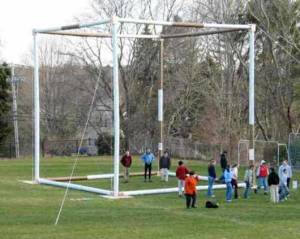Are You Helping to Save the World?
Are You Helping to Save the World?
by AJ Walther, COTP
Photo source: http://www.sustainablemilton.org
How many of these cubes of CO2 can be saved just by not traveling to receive training? Let's compare a 17-person onsite class with a 17-person online class. The onsite class will be held in a centrally-located city in the U.S.: Topeka, Kansas.
To attend the onsite class, all 17 people will have to fly in from cities all across the country (and a few from outside the country). The instructor, who lives locally, will drive to the training facility.
So let's start with the instructor. She lives 35 miles away from the training facility and drives a 2004 Toyota Camry. Her roundtrip travel carbon emission for the day: .03 metric tons of CO2.
Now let's talk about the students. There's someone from Maryland, California, North Dakota, Pennsylvania, Michigan, Illinois, and North Carolina. There are two people from New York and from Colorado. Additionally there are three people from Minnesota. But that's just the United States. There are also students from the United Kingdom, Puerto Rico and Quebec. The roundtrip Domestic travel carbon emission: 7.12 metric tons of CO2. The roundtrip International travel carbon emission: 4.9 metric tons of CO2. Total: 12.05 metric tons of CO2 (or 26,565.43 pounds). That's 12 of those cubes pictured above. And that's not including travel incurred by students to get to their respective airports and from the airport to the training location.
I've just added up the CO2 requirement for one hypothetical onsite class. A training company can easily run 15 classes each month (we do... and that's 180 classes a year). Given the fact that many students will take the courses from home (the rest will attend from the office), it doesn't take a math wizard to see the dramatic CO2 savings online classes can provide each day and each year.
Want to help save the world? Consider teaching your classes online! Not sure you're ready? There's no better way to prepare than getting certified as the best in the field. Join a session with the International Council for Certified Online Training Professionals and get certified in two days (and, of course, it's all online!). Click here to learn more about ICCOTP and register to get certified.
Carbon footprint calculated using: http://www.carbonfootprint.com/
 AJ Walther, COTP, is IconLogic's Chief Creative Officer (CCO), a seasoned online trainer, eLearning graphic designer, and author of both "PowerPoint 2007: The Essentials" and "PowerPoint 2008 for the Macintosh: The Essentials." AJ made her own interdisciplinary studies major, focusing on writing and art. Her combined expertise in PowerPoint, graphic design, and writing allows her to bring a unique skillset to the eLearning community.
AJ Walther, COTP, is IconLogic's Chief Creative Officer (CCO), a seasoned online trainer, eLearning graphic designer, and author of both "PowerPoint 2007: The Essentials" and "PowerPoint 2008 for the Macintosh: The Essentials." AJ made her own interdisciplinary studies major, focusing on writing and art. Her combined expertise in PowerPoint, graphic design, and writing allows her to bring a unique skillset to the eLearning community.
You must be logged in to post a comment.
click here to log in



